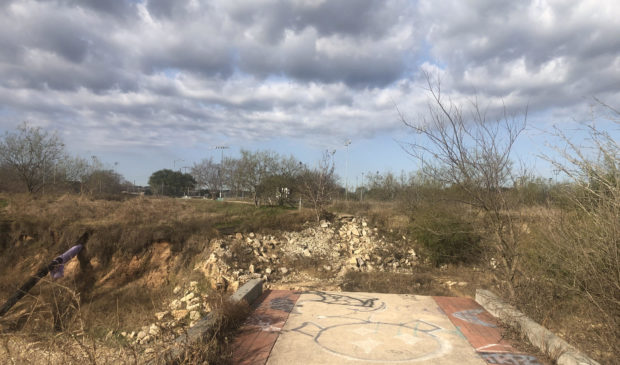Guerrero Park bridge delayed again
Monday, March 8, 2021 by
Harrison Young The long-awaited Guerrero Park bridge is now expected to be finished in 2024, according to the Watershed Protection Department.
Watershed anticipates construction to begin next year and to take two years to complete, according to project engineer Janna Renfro. The originally proposed completion date was 2018.
The bridge, which crosses Country Club Creek West in Roy G. Guerrero Park in East Austin, is a critical piece of infrastructure that connects the Ann and Roy Butler Hike-and-Bike Trail to the disc golf course, baseball fields and neighborhood of Montopolis.
Without the bridge, the fastest way to get through is a 3-mile journey along South Pleasant Valley Road and onto Grove Boulevard or by traveling through the disc golf course in the westernmost edge of the park. The bridge cuts that trek to 1.3 miles and avoids one of Austin’s most dangerous roadways.
“We want to make sure we’re the last ones to touch this and to make sure it will persist and perform for the community for generations to come,” Renfro said.
The delay is the latest in a long series of setbacks. The main burden on the timeline is the increasing complexity of the project, since the city conducts laboratory-scale experiments on bridge design options to ensure it will work as planned.
Floods washed out the bridge in 2015 and engineering to replace it began immediately. One of the primary complications is the growing erosion of the channel, causing the channel to widen upstream. Interim projects to mitigate the erosion have been completed over the years, including concrete barriers to protect the baseball fields and 2,700 tons of limestone laid to stabilize the area.
These projects “essentially act as Band-Aids to hold things together until we can get in and do a complete project,” Renfro said.
Construction of the bridge accompanies the Guerrero Park channel stabilization project. The Watershed Protection Department is responsible for the channel stabilization, and the Parks and Recreation Department handles the bridge, which will be completed simultaneously.
“It’s very safe to say this is a major civil engineering project,” Renfro said.
The $13 million project budget was fulfilled after the Federal Emergency Management Agency granted the city $8.5 million alongside $5.5 million from Austin’s Watershed Protection Department, and another $2.5 million came from the Parks and Recreation Department.
The channel stabilization project includes successive large concrete structures that create a “step” system that dissipates the heavy flow of water, decreasing the amount of erosion in the creek bed. The space created by the steps will allow native plants and wildlife to return to the area. Temporary fixes mitigate erosion for now, but cannot sustain it without the larger construction project.
The problems originate in 1976, when plans to use Country Club Creek as a diversion channel were abandoned, allowing the water to cut its own course and leading to large gullies in the park. The erosion has grown severe enough that a large-scale construction effort is the only solution, according to a 2016 memo to the parks board.
“This is a legacy drainage that now, 40 years later, we are having to contend with,” Renfro said.
This story has been changed since publication to add an alternative path through the park to Pleasant Valley.
The Austin Monitor’s work is made possible by donations from the community. Though our reporting covers donors from time to time, we are careful to keep business and editorial efforts separate while maintaining transparency. A complete list of donors is available here, and our code of ethics is explained here.
You're a community leader
And we’re honored you look to us for serious, in-depth news. You know a strong community needs local and dedicated watchdog reporting. We’re here for you and that won’t change. Now will you take the powerful next step and support our nonprofit news organization?










